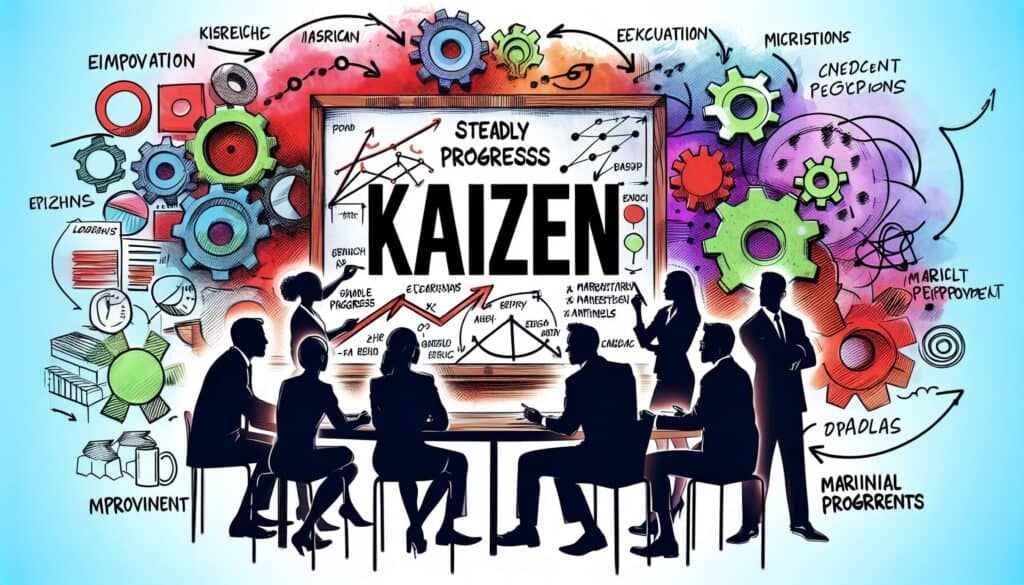Eine Philosophie und Praxis der kontinuierlichen, schrittweisen Verbesserung von Prozessen, Produkten und Dienstleistungen unter Einbeziehung aller Mitarbeiter eines Unternehmens.
- Methodologien: Maschinenbau, Qualität
Kaizen (Kontinuierliche Verbesserung)

Kaizen (Kontinuierliche Verbesserung)
- Kontinuierliche Verbesserung, Kaizen, Schlanke Fertigung, Plan-Do-Check-Act (PDCA), Prozessverbesserung, Prozess-Optimierung, Qualitätssicherung, Qualitätsmanagement
Zielsetzung:
Wie es verwendet wird:
- Beinhaltet regelmäßige Verbesserungsaktivitäten in kleinem Rahmen (z. B. Kaizen-Veranstaltungen oder Blitzaktionen, Vorschlagswesen), bei denen Teams Verschwendung oder Ineffizienzen erkennen, Lösungen erarbeiten, Änderungen umsetzen und erfolgreiche Verbesserungen standardisieren. Konzentriert sich auf PDCA-Zyklen.
Vorteile
- Fördert eine Kultur des kontinuierlichen Lernens und des Engagements der Mitarbeiter; führt zu allmählichen, aber signifikanten langfristigen Verbesserungen; ist kostengünstig und konzentriert sich oft auf Kreativität statt auf Kapitalinvestitionen; verbessert die Effizienz und reduziert Verschwendung.
Nachteile
- Erfordert ein starkes Engagement des Managements und eine unterstützende Kultur; kann nur langsam zu radikalen Veränderungen führen, wenn nur kleine Schritte unternommen werden; die Aufrechterhaltung der Dynamik kann eine Herausforderung sein; kann auf den Widerstand von Mitarbeitern stoßen, die an traditionelle Wege gewöhnt sind.
Kategorien:
- Ideenfindung, Lean Sigma, Herstellung, Problemlösung, Projektmanagement, Qualität
Am besten geeignet für:
- Förderung einer Kultur kontinuierlicher, schrittweiser Verbesserungen in allen Bereichen eines Unternehmens, um Qualität, Effizienz und Mitarbeiterzufriedenheit zu steigern.
Kaizen wird häufig in verschiedenen Branchen angewandt, z. B. in der Fertigung, im Gesundheitswesen und im Dienstleistungssektor, wo kontinuierliche Verbesserungen die betriebliche Effizienz erheblich steigern können. Während der Entwicklungsphase eines Produkts können Teams Kaizen-Events oder Blitzaktionen initiieren, bei denen funktionsübergreifende Gruppen zusammenkommen, um bestimmte Bereiche der Verschwendung oder Ineffizienz innerhalb von Prozessen zu ermitteln. In einer Produktionsumgebung könnte sich Kaizen beispielsweise auf die Optimierung von Fließbandverfahren durch kleine Anpassungen konzentrieren, die Ausfallzeiten minimieren oder überflüssige Schritte eliminieren. Einrichtungen des Gesundheitswesens setzen Kaizen häufig ein, um den Patientenfluss und die Ressourcenzuweisung zu verbessern, so dass das Personal Lösungen entwickeln kann, die die Pflege verbessern, ohne dass dafür erhebliche Budgeterhöhungen erforderlich sind. Zu den teilnehmenden Teammitgliedern können Ingenieure, Qualitätssicherungsexperten, Mitarbeiter an der Basis und das Management gehören, die alle ihre einzigartigen Perspektiven und ihr Fachwissen in den Problemlösungsprozess einbringen. Der Einsatz von PDCA-Zyklen (Plan-Do-Check-Act) ermöglicht es den Teams, Verbesserungen systematisch umzusetzen, die Auswirkungen zu überwachen und erfolgreiche Änderungen zu standardisieren. Diese Methoden können zu einer Kultur führen, in der sich die Mitarbeiter ermächtigt fühlen, kontinuierliche Verbesserungen vorzuschlagen, was letztlich ein Gefühl der Eigenverantwortung und des Engagements für das Erreichen von Spitzenleistungen innerhalb der Organisation erzeugt. Wenn sich die Verbesserungen im Laufe der Zeit summieren, können die Ergebnisse die betrieblichen Fähigkeiten verändern, die Kundenzufriedenheit erhöhen und ein nachhaltiges Umfeld fördern, in dem kontinuierliches Lernen zum festen Bestandteil des Unternehmensethos wird.
Die wichtigsten Schritte dieser Methodik
- Ermittlung von Verbesserungsmöglichkeiten durch Zusammenarbeit und Beobachtung.
- Brainstorming über mögliche Lösungen für festgestellte Ineffizienzen.
- Umsetzung ausgewählter Verbesserungen in kleinem Maßstab oder in Pilotversuchen.
- Standardisieren Sie erfolgreiche Änderungen, um eine einheitliche Anwendung zu gewährleisten.
- Überprüfen Sie die Auswirkungen der durchgeführten Änderungen und sammeln Sie Feedback.
- Wiederholen Sie den Zyklus, um kontinuierlich nach weiteren Verbesserungen zu suchen.
Profi-Tipps
- Einbindung von funktionsübergreifenden Teams in Kaizen-Veranstaltungen, um unterschiedliche Perspektiven zu nutzen und die Problemlösungskapazitäten zu verbessern.
- Nutzen Sie die Datenanalyse, um spezifische Bereiche der Verschwendung zu identifizieren und die Entscheidungsfindung bei Verbesserungsinitiativen zu unterstützen.
- Einrichtung einer soliden Feedbackschleife nach der Implementierung, um die langfristigen Auswirkungen der Änderungen zu bewerten und die Prozesse kontinuierlich zu verbessern.
Verschiedene Methoden lesen und vergleichen, Wir empfehlen die
> Umfassendes Methoden-Repository <
zusammen mit den über 400 anderen Methoden.
Ihre Kommentare zu dieser Methodik oder zusätzliche Informationen sind willkommen auf der Kommentarbereich unten ↓ , sowie alle ingenieursbezogenen Ideen oder Links.
Historischer Kontext
1950
1980
1980
1986
1994
1995
2000
1960
1980
1983
1990
1995
2000
2010
(wenn das Datum nicht bekannt oder nicht relevant ist, z. B. "Strömungsmechanik", wird eine gerundete Schätzung des bemerkenswerten Erscheinens angegeben)














Verwandte Artikel
Management der Produktionsabläufe (MOM)
Fertigungsausführungssystem (MES)
Produktionslenkungsplan
Manuelle Prüfung
Bewertungsbögen für die manuelle Handhabung (MAC)
ManTRA (Instrument zur Risikobewertung manueller Tätigkeiten)